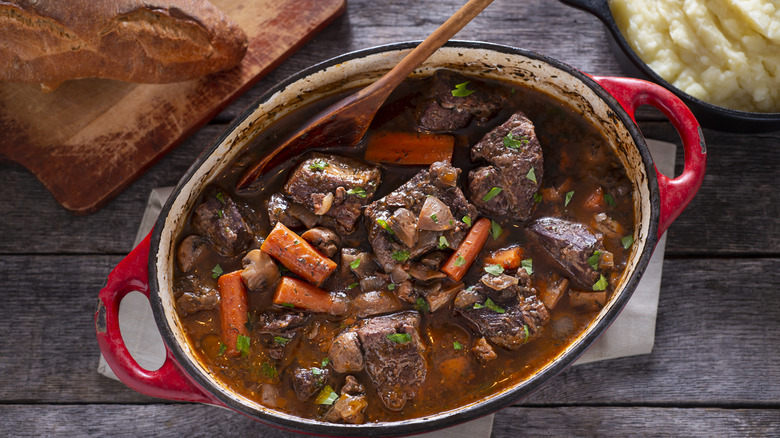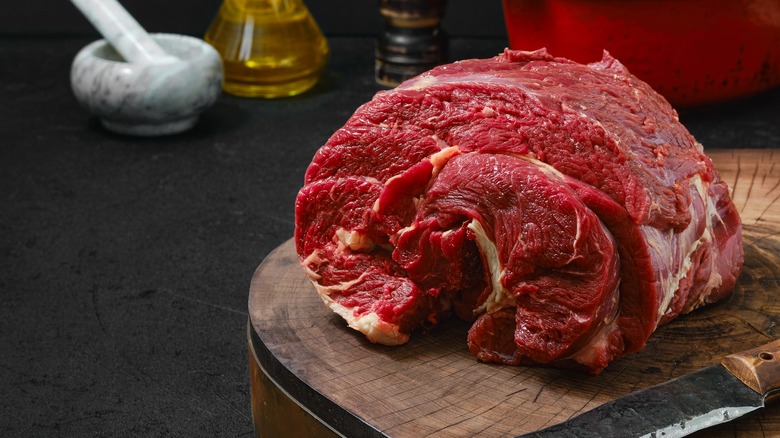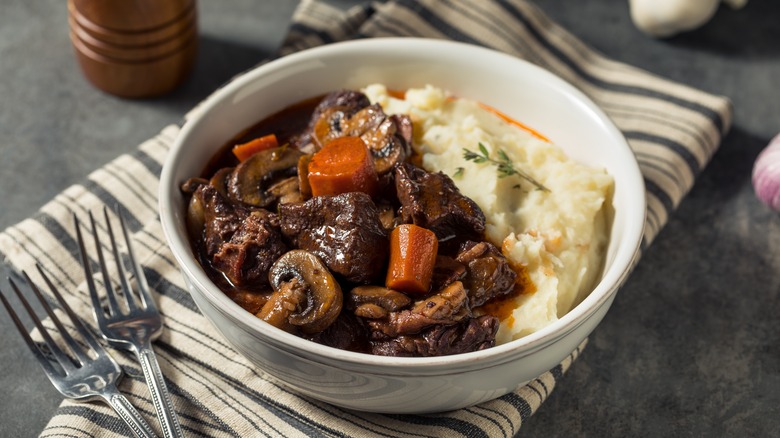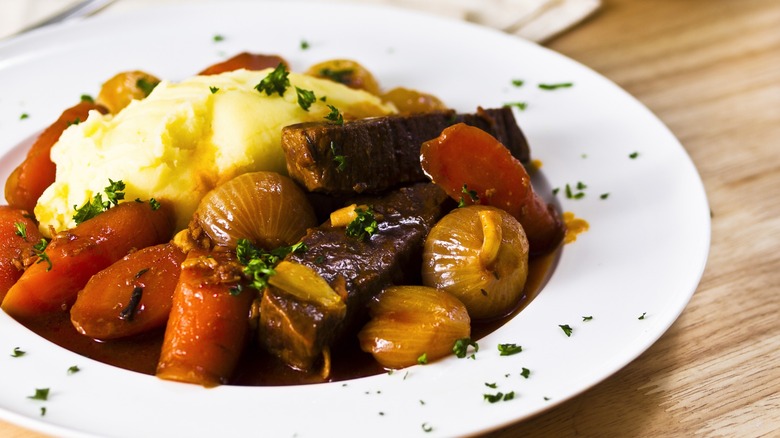The Underrated Cut Of Beef That's Perfect For Braising
These days, beef is generally not the cheapest meat available. So, if you're trying to keep costs down, opt for less expensive cuts of beef and cook them appropriately. No matter how skilled you are at grilling, cuts like shin meat or rump steak won't magically transform into filet mignon. However, braising these tougher cuts can help make them tender.
When looking for affordable, braising-friendly beef, chuck roast is arguably the go-to choice. Yet, it's not the only option: One underrated cut ideal for braising is the beef neck. Although it's sometimes maligned as a tougher and chewier cut due to its origin from a highly active part of the cow –– and to be clear, if you try to cook it on a grill or in a frypan like a steak, it will likely be a serious workout for your jaw. But if you cook it low and slow, either in a Dutch oven or a slow cooker, beef neck develops a deep, rich flavor. This method makes it a budget-friendly choice without compromising on taste.
How braising softens up beef neck
The standard advice for cooking cheaper cuts of beef, such as beef neck, is to slow cook them in recipes like pot roast or boeuf bourguignon. Over time, this method makes them tender and juicy, eliminating any chewiness. The beef neck, with its tendons and bones, is fundamentally unsuitable for quick and hot cooking methods like frying or grilling, unless you're in the mood for a supremely chewy meal.
Professional recommendations for cooking beef neck almost always suggest braising or stewing. For the record, these methods both employ a low-and-slow approach, but differ in the amount of liquid used. Stewing involves more liquid, like water or stock, whereas braising requires the meat to be only partially covered. Beef neck, like other tough cuts, contains a lot of collagen. When cooked in liquid, this collagen dissolves, allowing the meat fibers to break apart and become tender. However, it's essential to maintain a moderately low cooking temperature. A pot of boiling broth may dissolve the collagen, but will also toughen and shrink the meat fibers, resulting in tough meat.
What to cook with beef neck
Most, if not all, recipes designed for tougher cuts of beef should work well with beef neck — the same scientific principles apply, so substituting beef neck for a cut like chuck typically doesn't require special adjustments. When choosing what to cook, the sky's the limit as long as you adhere to the low-and-slow cooking method. Classic dishes like an old-fashioned beef stew or French-style boeuf bourguignon, loaded with vegetables, wine, stock, and herbs, are obvious choices. You'll likely need about three pounds of meat, but this can be increased for larger batches.
Alternatively, you could explore dishes like a slow-cooked curry, or use braised beef neck as a filling for hearty tacos — juicy birria tacos are also a great option. Whatever you choose, ensure there is sufficient liquid (the meat should be at least partially covered) — stock and other flavor enhancers are essential for adding extra flavor to the beef neck's rich taste. Most importantly, allow ample time for the neck to cook slowly; three hours is a good starting point, although there's nothing stopping you from cooking longer.
Subbing in beef neck
Let's look at how you can use beef neck, using Julia Child's famed beef bourguignon. All ingredients will stay the same, except for the beef cut. Because beef neck contains bones (and the original recipe uses a boneless beef cut), you're going to need more of it. Beef neck is up to 70% bone, so this could mean up to three times the weight in beef neck. Child's recipe calls for 2 pounds of chuck, so you may need up to 6 pounds of neck. You might be worried about how much this will cost, but don't worry, beef neck is a much cheaper cut. But ask your butcher about it: If the neck cuts on offer are on the meaty side, you can get away with less.
Per Child's recipe, follow the recipe's initial steps for cooking the bacon, keeping the fat in the pan when it's done. Next, brown the beef neck in the bacon fat. With more meat to brown, you may need to do this in rounds. You may also need to add extra fat for the later rounds: Perhaps a little butter. You can then follow the rest of the recipe, but you'll have to decide whether or not to remove the bones. Bourguignon is typically boneless, but slow-braising it with the bones in will give a richer flavor. Alternatively, you could remove them at the end, but this will be a finicky process of pulling them out of the stew. Whichever you choose, it should still be a deliciously beefy meal made even better by using this undervalued cut of meat.



